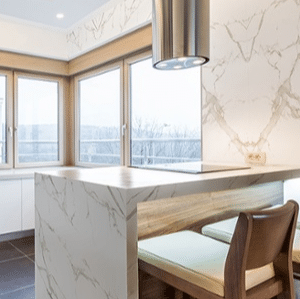Porcelain Countertops vs. Quartz: Which Engineered Surface is Right for Your Home?

While there are many benefits to consider with each option, one of the main draws for both quartz and porcelain is the sheer variety of looks you can find.
In addition to colors and patterns not seen in nature, both of these surfaces can be made to look like your favorite natural stone varieties, from Carrera or Calacatta marble to dappled granite, but with more affordable pricing. With either, you should have no trouble finding the exact look you want, whether it’s natural or not. The question is: is porcelain or quartz better for your home and application? Here are a few important considerations to think about when choosing the right countertop surfaces for your home.
Both Offer Convenience and Resilience
Natural stone slabs like marble and granite are certainly beautiful, but one area where engineered surfaces excel is the fact that they are non-porous. Natural stone surfaces must be sealed to prevent the intrusion of stains, bacteria, mold, and so on. They require special care and regular sealing to maintain their beauty and function.
However, this is not the case with quartz and porcelain, where finishes are essentially built-in. Quartz particles are bound together with resin and polymers, while porcelain finishes are baked in extremely high temperatures, resulting in non-porous surfaces that are food-safe and easy to clean and maintain. Both resist staining, but porcelain is also resistant to fading from UV rays, making it an ideal addition to both indoor and outdoor spaces. Porcelain is heat-resistant, as well.
Both surfaces are relatively resistant to scratching. Although, porcelain can be scratched with ceramic knives, so you may want to avoid using them directly on the surface. Because of the way it’s manufactured, quartz will resist chips and cracks better than many other countertop surfaces, including porcelain.
Quartz Has More Depth
On cursory inspection, it’s very likely the average person won’t be able to tell the difference between quartz, porcelain, and the natural stone they’ve been made to resemble. Naturally, quartz and porcelain feel different to the touch, so a closer examination might reveal the nature of the countertop, especially to experienced professionals. However, you can typically enjoy a surface that closely resembles natural stone, whether you choose quartz or porcelain.
That said, there is a difference in how these two engineered products are made. Quartz is comprised of a combination of crushed rock, resin, polymers, and in some cases, pigments that create a specific appearance, such as mimicking other natural stones like marble or granite. Because of this, the color and pattern permeate the entire slab.
On the other hand, the patterns on porcelain are only on the surface, and this could cause a certain lack of depth. While not generally noticeable, it can become obvious if the surface is somehow marred, such as by cutting it with a ceramic knife. In this case, the nature of the countertop may appear less “natural stone-like” because the veining or other patterns do not extend below the surface.
Slab Size and Thickness
One of the main draws of porcelain and quartz countertops is that, because they are engineered, they can come in impressively large sizes. If you have a large or oddly-shaped area to cover, you may require multiple slabs of marble or granite. This can create seams (if you use a professional fabricator, these seams are barely noticeable). However, since quartz and porcelain both come in larger size slabs, you’ll be less likely to deal with any seams. Depending on the size of your application, you may only need to use one slab so you may enjoy a seamless, uniform surface.
While porcelain is extremely durable, it is typically thinner than quartz. Because of this, you can be limited when it comes to finishing details, like edging. Often, mitered edges are used to create the illusion of a thicker countertop surface. Few edge options are currently available for porcelain, but due to increasing popularity, it’s likely that more options will soon become available.
Both Are Considered Recyclable
With more and more consumers demanding products that produce less environmental impact, the demand for “greener” options is growing. If you are environmentally conscious, you’ll be happy to learn that both quartz and porcelain are both considered to be a “green” countertop surface. And after your initial investment, if you ever decide to upgrade or replace your countertops, both surfaces are recyclable.
Need Help on Your Next Project?
We specialize in creating custom countertops in Fairfield County, CT and Westchester County, NY and partner with leading quartz and porcelain suppliers from around the world. Please visit us today or contact us here to learn more.


